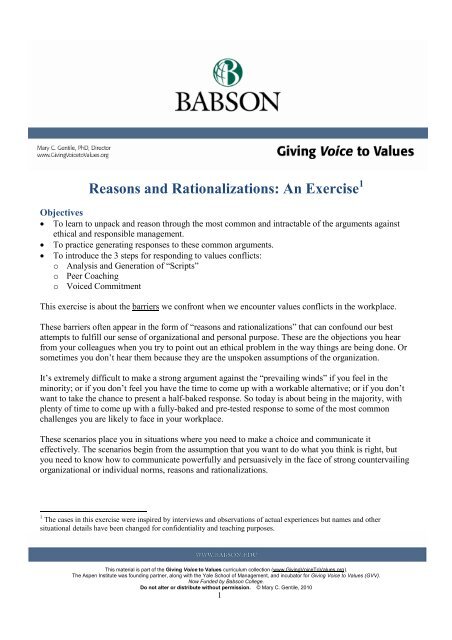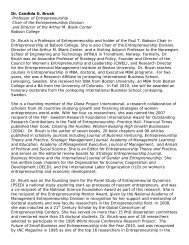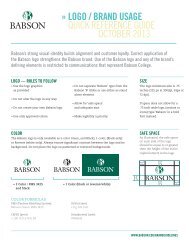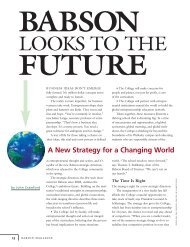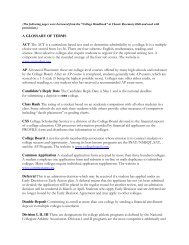Reasons & Rationalizations - Babson College
Reasons & Rationalizations - Babson College
Reasons & Rationalizations - Babson College
You also want an ePaper? Increase the reach of your titles
YUMPU automatically turns print PDFs into web optimized ePapers that Google loves.
<strong>Reasons</strong> and <strong>Rationalizations</strong>: An Exercise 1<br />
Objectives<br />
To learn to unpack and reason through the most common and intractable of the arguments against<br />
ethical and responsible management.<br />
To practice generating responses to these common arguments.<br />
To introduce the 3 steps for responding to values conflicts:<br />
o Analysis and Generation of “Scripts”<br />
o Peer Coaching<br />
o Voiced Commitment<br />
This exercise is about the barriers we confront when we encounter values conflicts in the workplace.<br />
These barriers often appear in the form of “reasons and rationalizations” that can confound our best<br />
attempts to fulfill our sense of organizational and personal purpose. These are the objections you hear<br />
from your colleagues when you try to point out an ethical problem in the way things are being done. Or<br />
sometimes you don’t hear them because they are the unspoken assumptions of the organization.<br />
It’s extremely difficult to make a strong argument against the “prevailing winds” if you feel in the<br />
minority; or if you don’t feel you have the time to come up with a workable alternative; or if you don’t<br />
want to take the chance to present a half-baked response. So today is about being in the majority, with<br />
plenty of time to come up with a fully-baked and pre-tested response to some of the most common<br />
challenges you are likely to face in your workplace.<br />
These scenarios place you in situations where you need to make a choice and communicate it<br />
effectively. The scenarios begin from the assumption that you want to do what you think is right, but<br />
you need to know how to communicate powerfully and persuasively in the face of strong countervailing<br />
organizational or individual norms, reasons and rationalizations.<br />
1 The cases in this exercise were inspired by interviews and observations of actual experiences but names and other<br />
situational details have been changed for confidentiality and teaching purposes.<br />
This material is part of the Giving Voice to Values curriculum collection (www.GivingVoiceToValues.org).<br />
The Aspen Institute was founding partner, along with the Yale School of Management, and incubator for Giving Voice to Values (GVV).<br />
Now Funded by <strong>Babson</strong> <strong>College</strong>.<br />
Do not alter or distribute without permission. © Mary C. Gentile, 2010<br />
1
After reading the scenario, please work through the following questions:<br />
What are the main arguments you are trying to counter? That is, what are the reasons and<br />
rationalizations you need to address?<br />
What is at stake for the key parties, including those who disagree with you?<br />
What levers can you use to influence those who disagree with you?<br />
What is your most powerful and persuasive response to the reasons and rationalizations you need<br />
to address? To whom should the argument be made? When and in what context?<br />
This material is part of the Giving Voice to Values curriculum collection (www.GivingVoiceToValues.org).<br />
The Aspen Institute was founding partner, along with the Yale School of Management, and incubator for Giving Voice to Values (GVV).<br />
Now Funded by <strong>Babson</strong> <strong>College</strong>.<br />
Do not alter or distribute without permission. © Mary C. Gentile, 2010<br />
2
Case #1<br />
Maureen works as an engineering manager in the Product Group for a leading computer systems<br />
company. She recently learned, through informal conversation with some of her colleagues, that the<br />
firm’s single-wipe hard-drive reconfiguration process is failing 5% of the time. This means that<br />
customers can be purchasing reconditioned hard-drives that still have the previous owner’s data on<br />
them. She and her colleagues speculate that it could cost upwards of $5 million to address this glitch<br />
with the reconfiguration process, so no one really wants to name or “own” the problem. After all, there<br />
have been no complaints outside the company and this has probably been going on for at least 6 months.<br />
Still Maureen is uncomfortable. She is worried not only about meeting the expectations of customers<br />
who have paid for a clean system, but also about the violation of privacy of the previous owners of these<br />
systems. It’s just not a product situation she can feel good about.<br />
Ideally, Maureen would like to get her colleagues to take the concern up the organization together with<br />
her. She thinks it will have more impact that way. On the other hand, no one wants to be the one to<br />
break this news. Especially since there have been recent cutbacks, money is tight, and no one wants to<br />
have to charge more against their group’s expenses. At least for now, it feels to folks in her group that<br />
“ignorance is bliss.” And no one expects to be thanked for calling attention to the problem. The question<br />
is: who will be blamed if it surfaces?<br />
What should she say, to whom, when and how?<br />
Discussion Questions<br />
What are the main arguments you are trying to counter? That is, what are the reasons and<br />
rationalizations you need to address?<br />
What’s at stake for the key parties, including those with whom you disagree?<br />
What levers can you use to influence those with whom you disagree?<br />
What is your most powerful and persuasive response to the reasons and rationalizations you<br />
need to address?<br />
This material is part of the Giving Voice to Values curriculum collection (www.GivingVoiceToValues.org).<br />
The Aspen Institute was founding partner, along with the Yale School of Management, and incubator for Giving Voice to Values (GVV).<br />
Now Funded by <strong>Babson</strong> <strong>College</strong>.<br />
Do not alter or distribute without permission. © Mary C. Gentile, 2010<br />
3
Case #2<br />
Jeff is proud to manage the highest performing sales team in his computer hardware company. His group<br />
focuses on institutional end-users and has led the firm for almost two years now. Jeff took over the<br />
group 9 months ago and is pleased and relieved that they have been able to continue the winning streak<br />
under his leadership.<br />
Nevertheless, lately he has been finding himself losing sleep over an ever growing list of questionable<br />
practices he had begun to notice. He recognizes the intense pressure his folks are under to meet and even<br />
exceed their numbers – pressures that come from the company, on the one hand, and from the intense<br />
personal competitiveness that his salespeople bring to their jobs on the other. And then there are the<br />
bonuses, and the desire to please, and thereby retain customers.<br />
Nevertheless, over the past few months, as he becomes more familiar with his staff and their routines<br />
and as they come to trust him more, Jeff sees evidence of activities that worry him: sales representatives<br />
who override the sales reporting systems in order to get the customer the price he or she wants (Jeff<br />
heard about this one from a colleague in operations who was complaining about unrealistic demands.);<br />
reps who interact inappropriately with customers (for example, Jeff has heard rumors of reps sharing<br />
pornography via the company e-mail), in order to win their loyalty; reps who over-promise or who use<br />
special promotions inappropriately in order to seal the deal (again, rumors); reps who submit<br />
unrequested credit financing applications for their customers in order to get the associated bonus (in this<br />
instance, one of the administrators processing the request approached Jeff because the paperwork looked<br />
fishy to him); etc.<br />
Jeff is concerned about these practices for many reasons, but he is also worried about messing around<br />
with a winning formula. He wants to clean up his shop but doesn’t want to undermine the motivation<br />
and competitive spirit of his staff.<br />
What should he say, to whom, when and how?<br />
Discussion Questions<br />
What are the main arguments you are trying to counter? What are the reasons and<br />
rationalizations you need to address?<br />
What’s at stake for the key parties, including those with whom you disagree?<br />
What levers can you use to influence those with whom you disagree?<br />
What is your most powerful and persuasive response to the reasons and rationalizations you<br />
need to address?<br />
Last Revised: 02/28/2010<br />
This material is part of the Giving Voice to Values curriculum collection (www.GivingVoiceToValues.org).<br />
The Aspen Institute was founding partner, along with the Yale School of Management, and incubator for Giving Voice to Values (GVV).<br />
Now Funded by <strong>Babson</strong> <strong>College</strong>.<br />
Do not alter or distribute without permission. © Mary C. Gentile, 2010<br />
4


